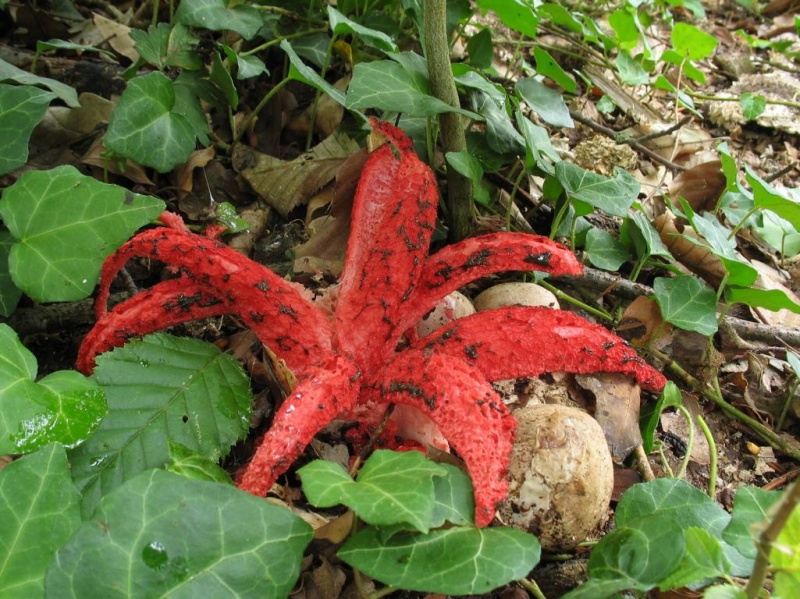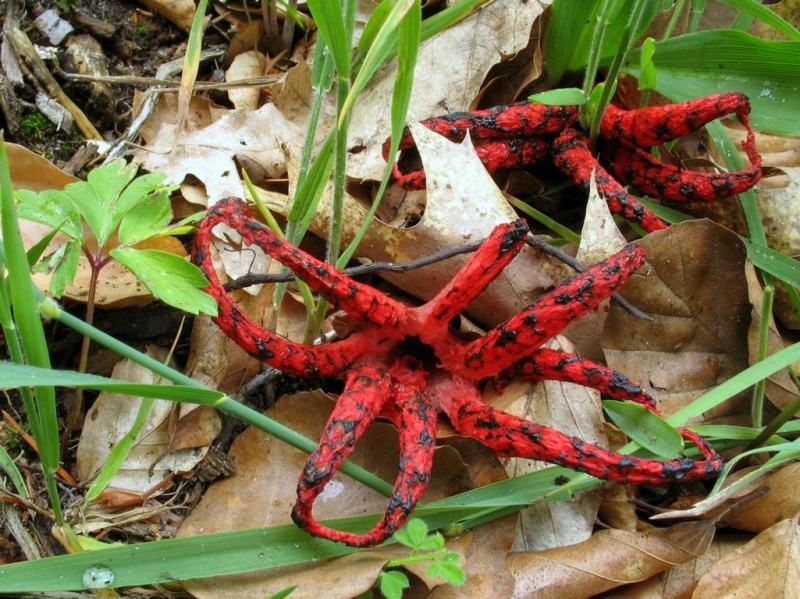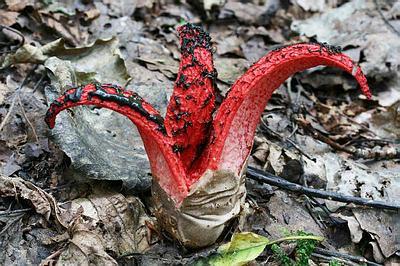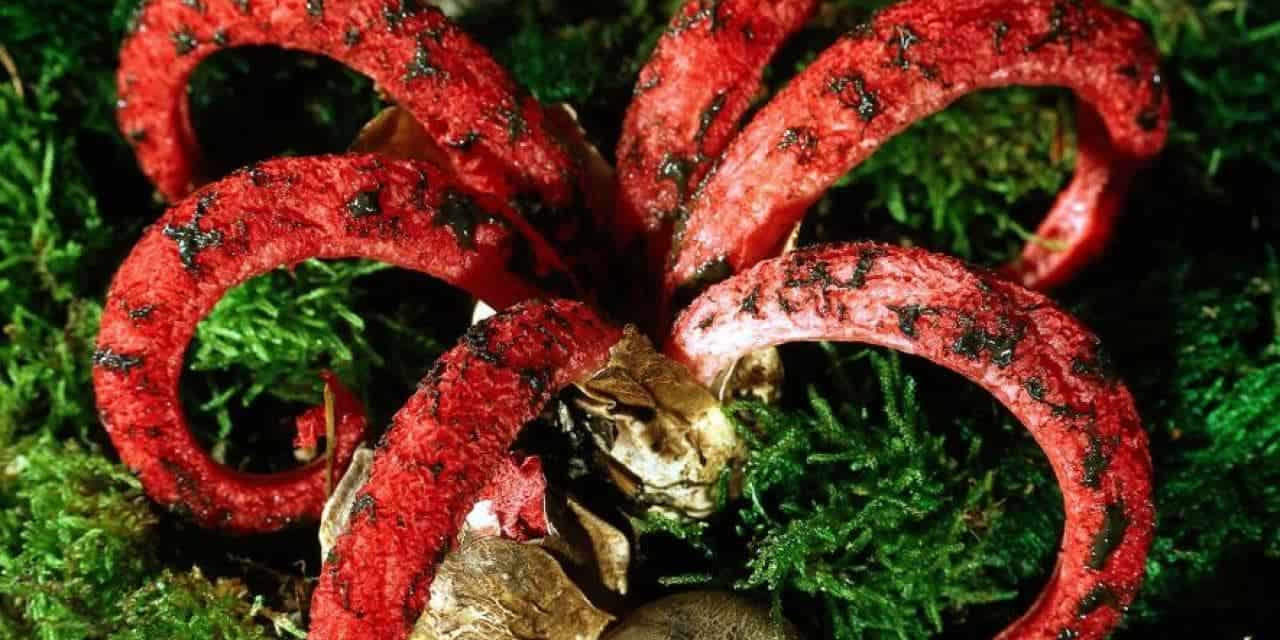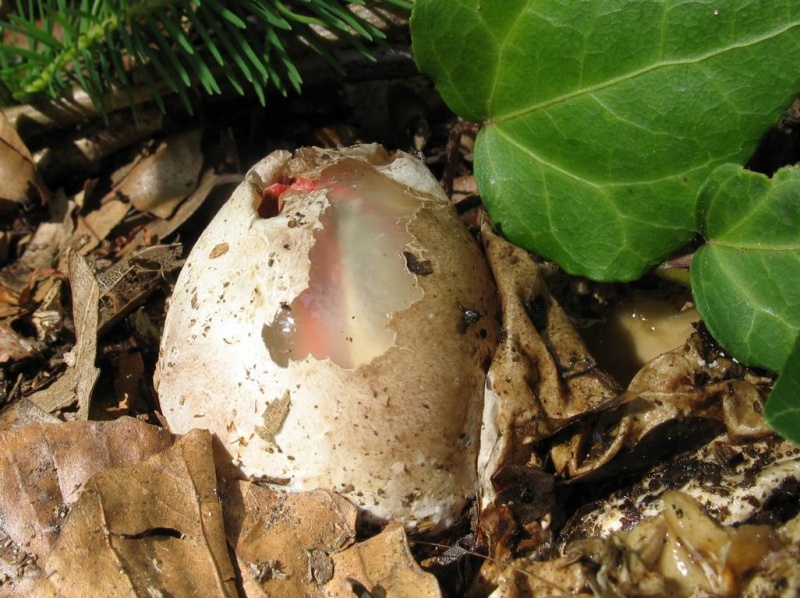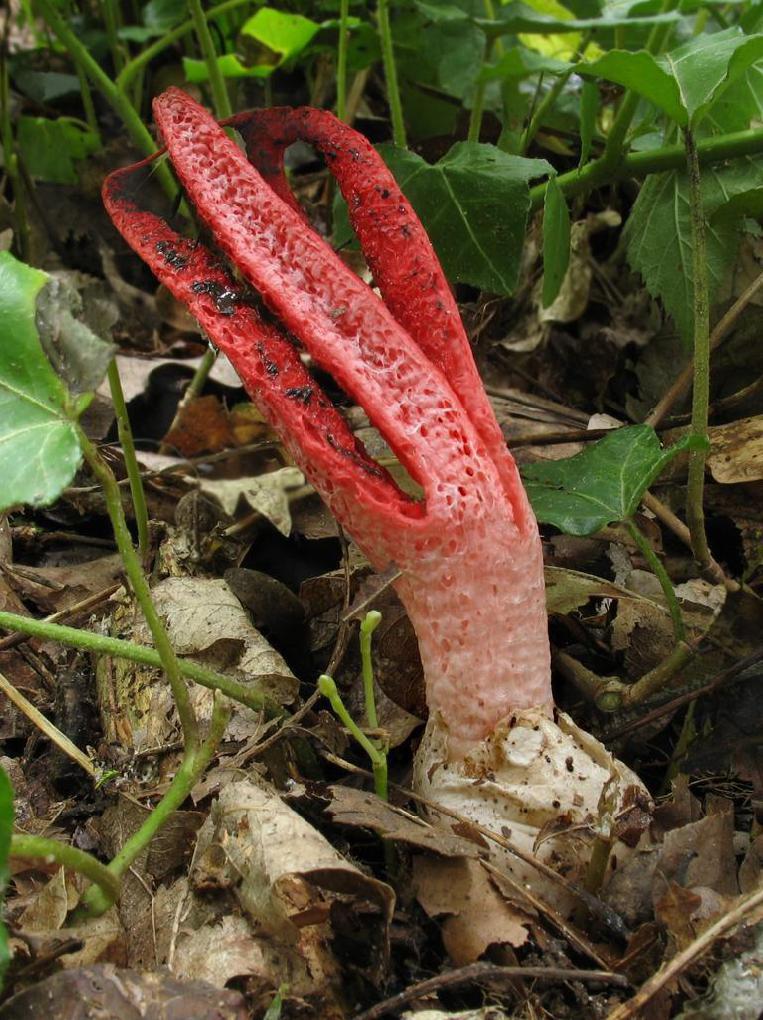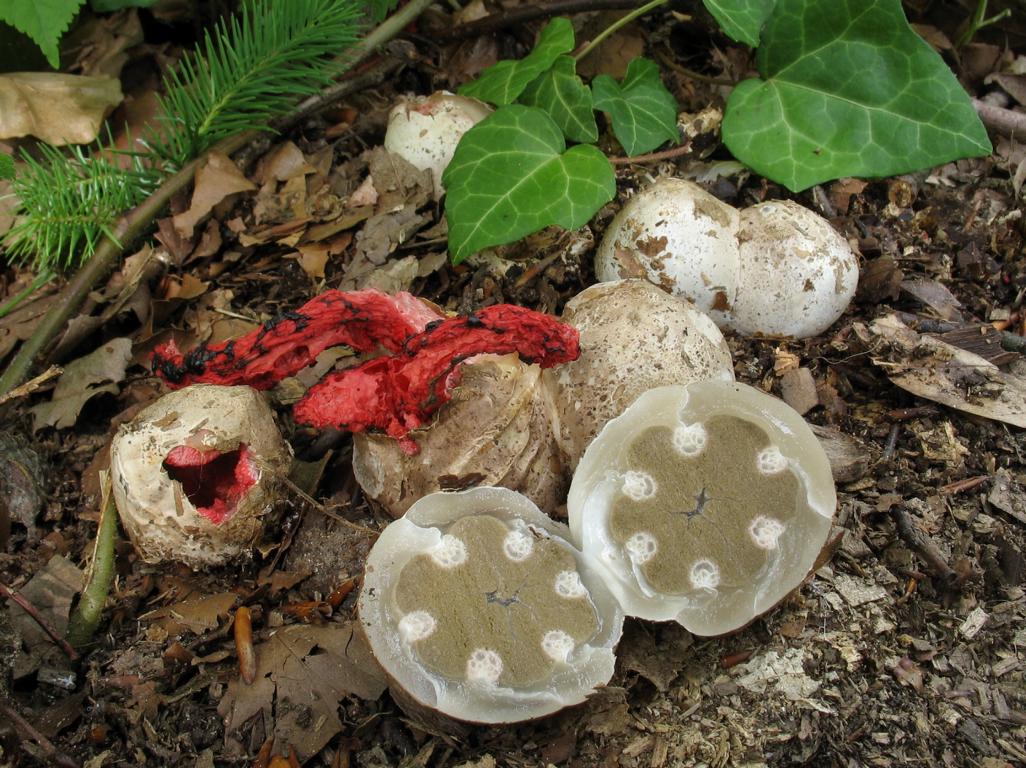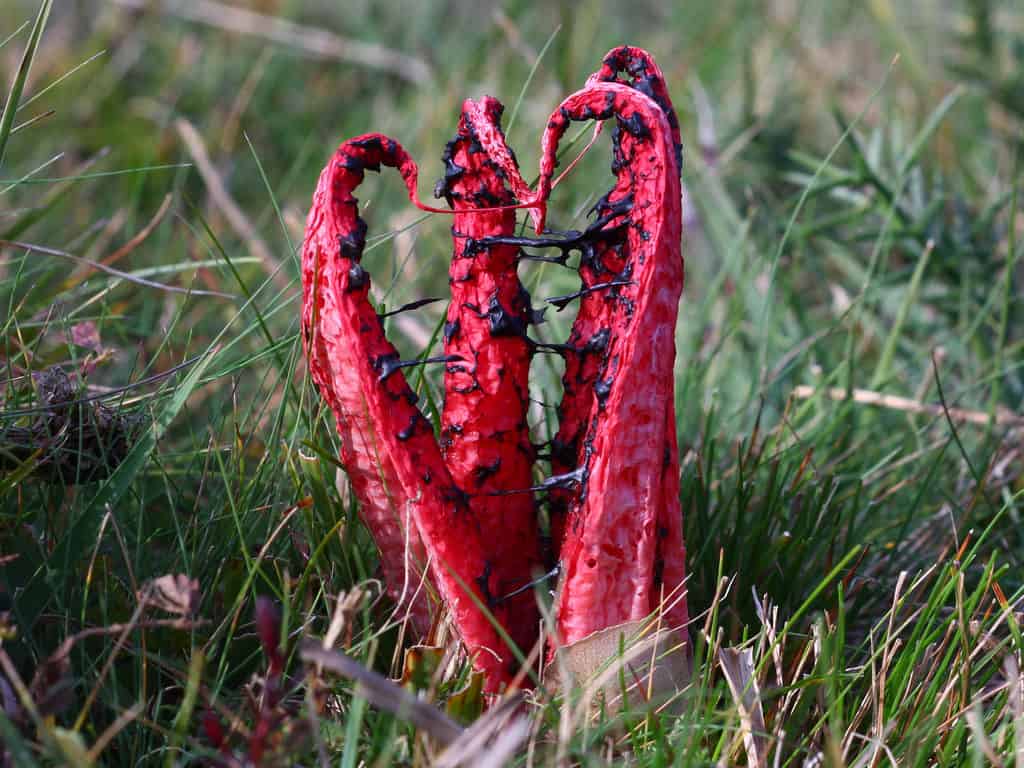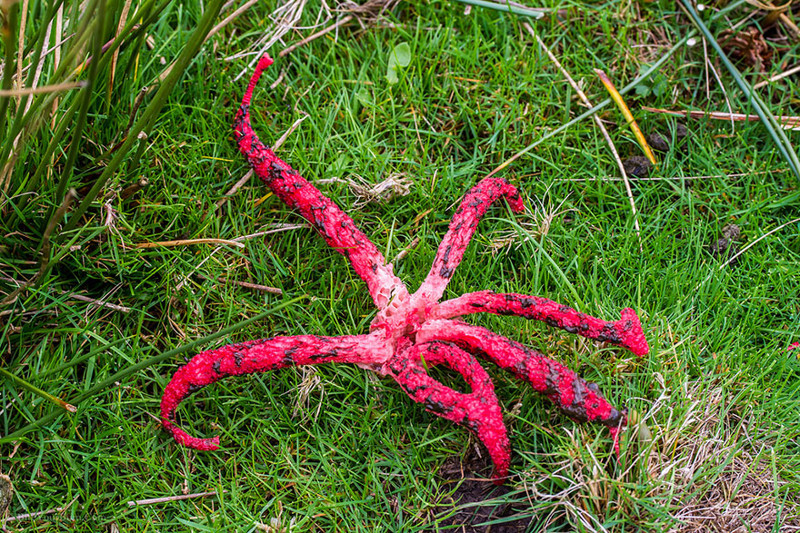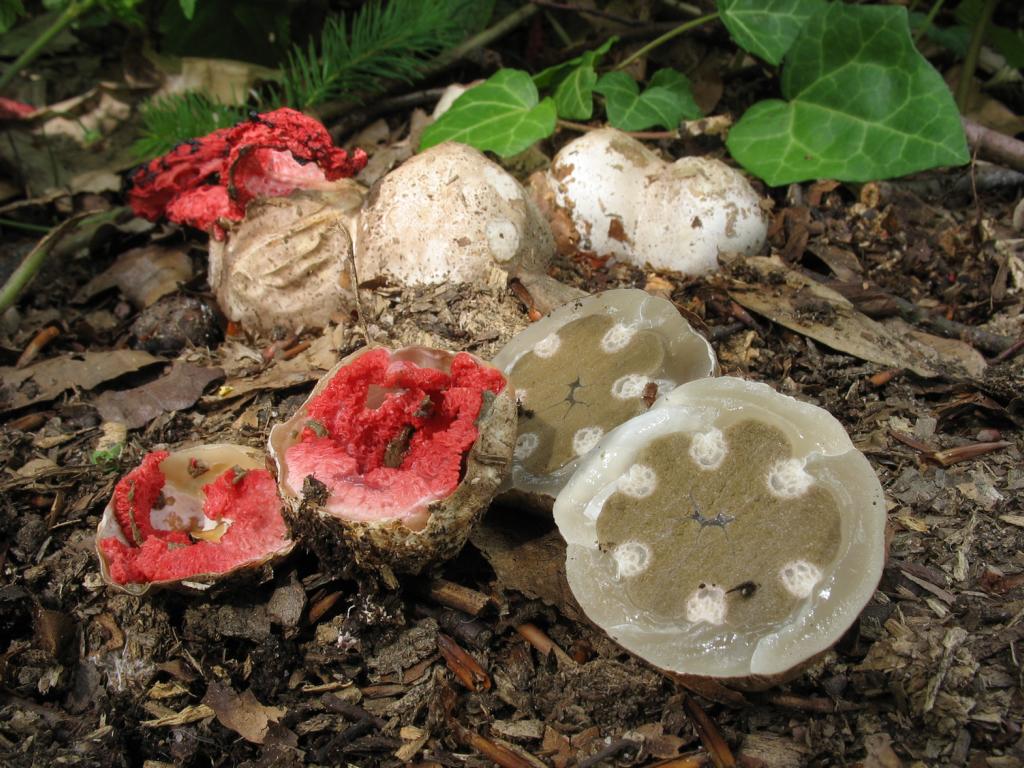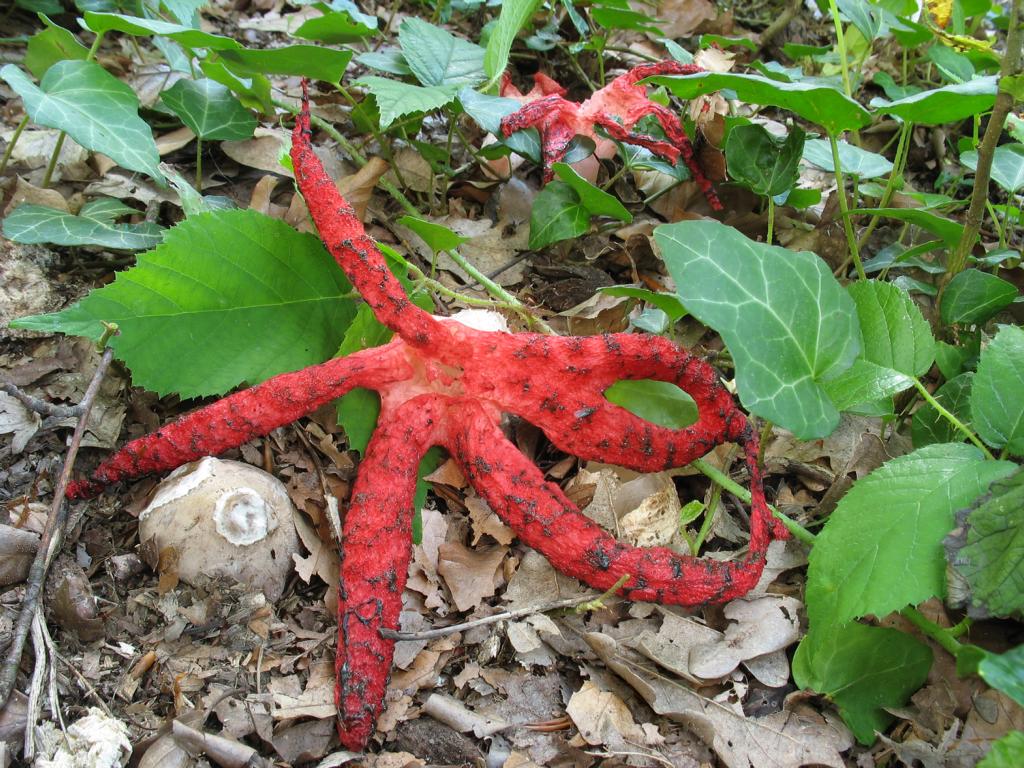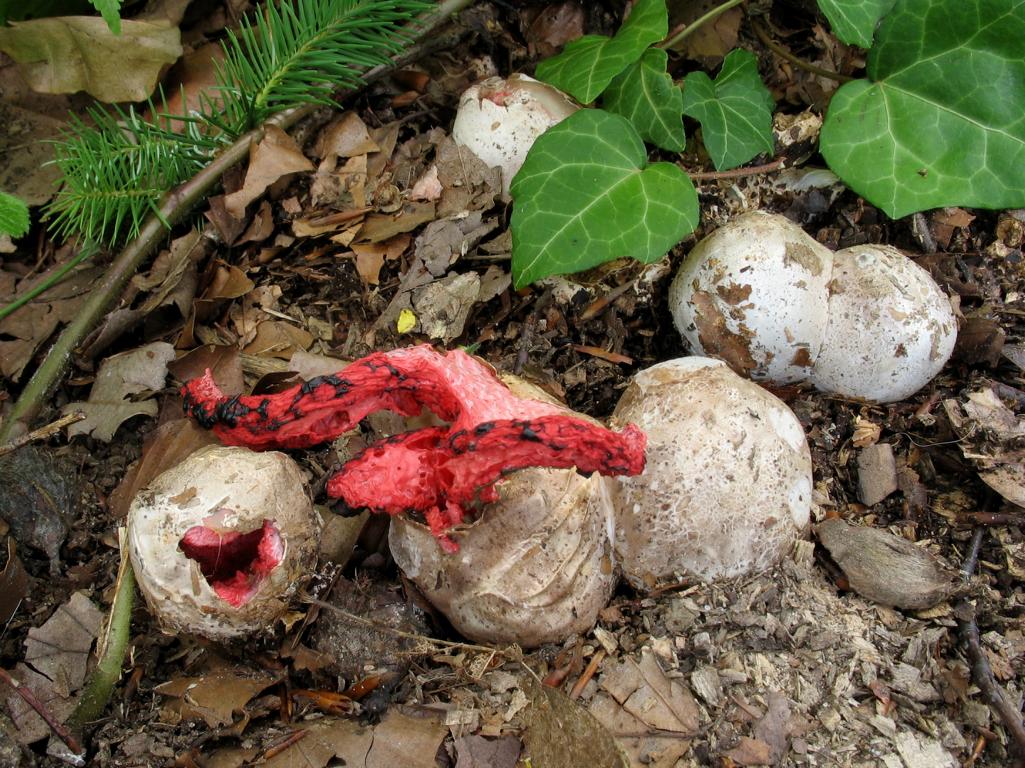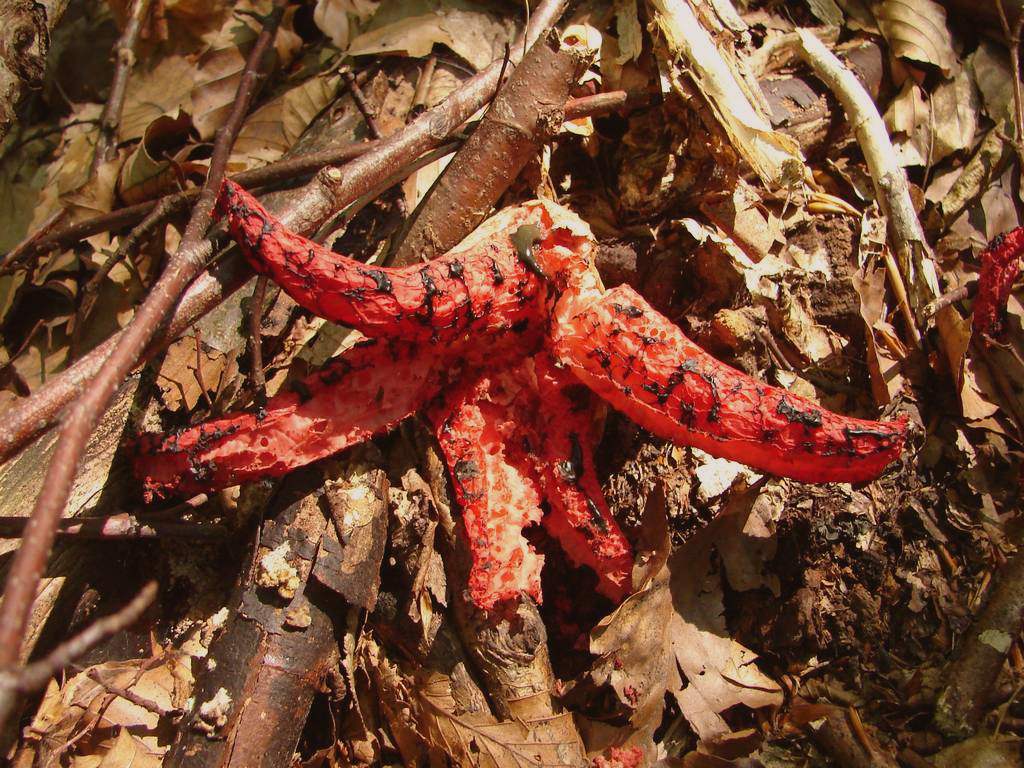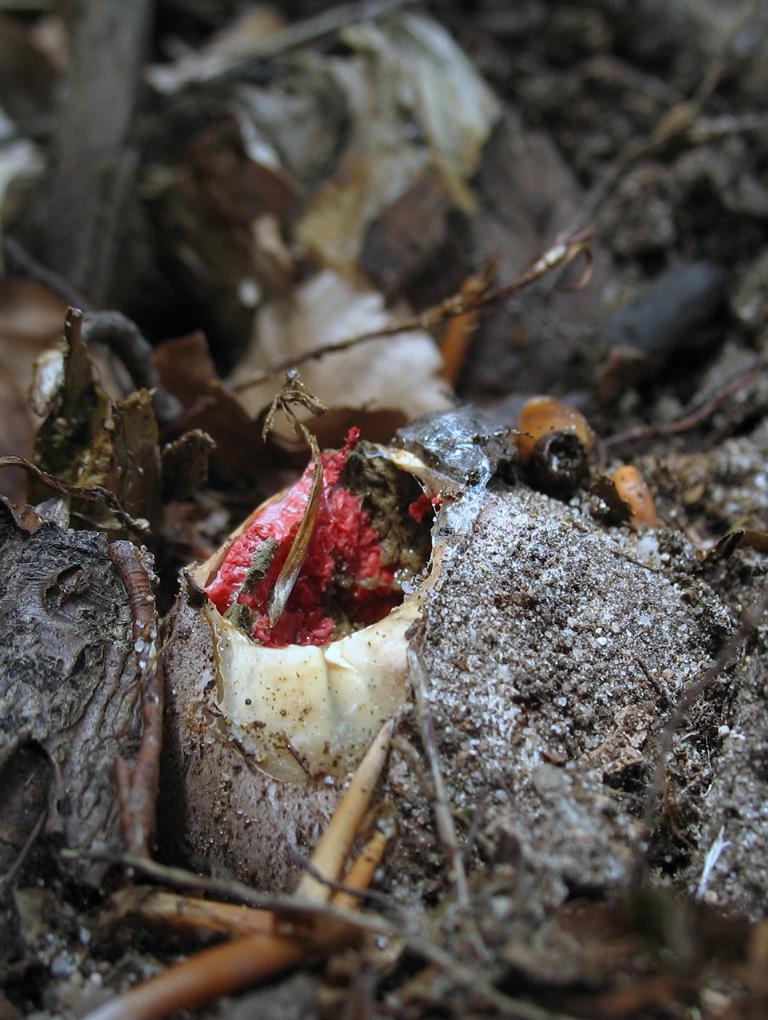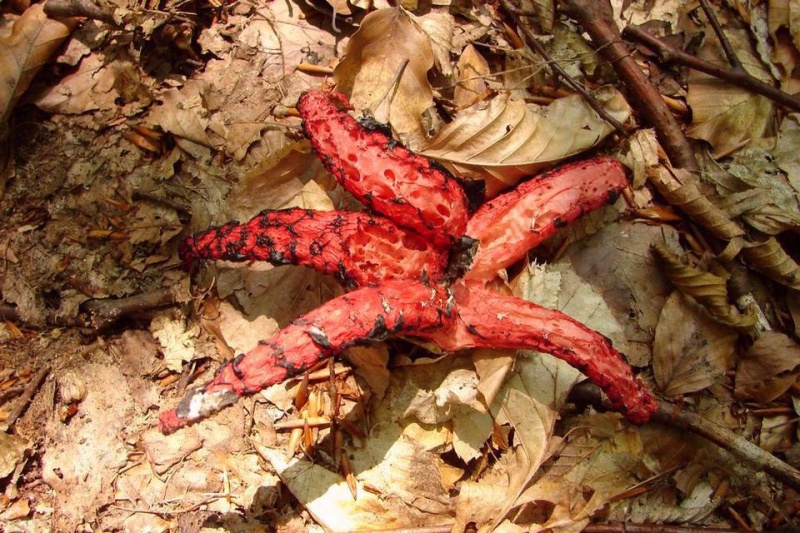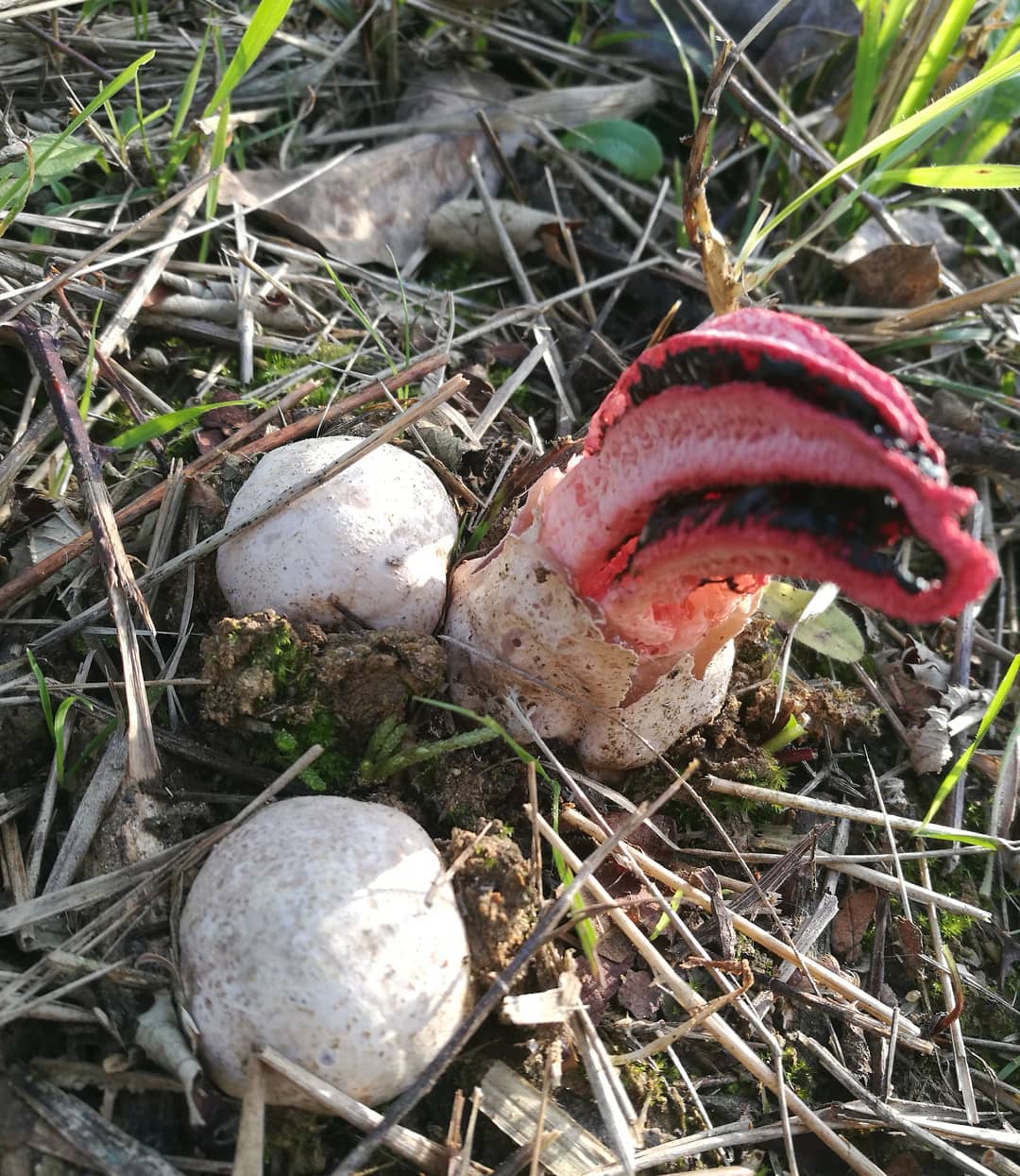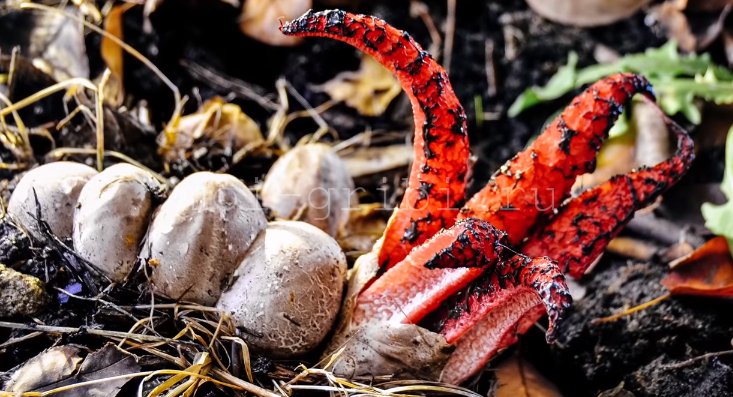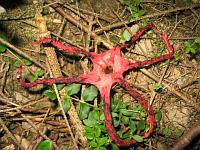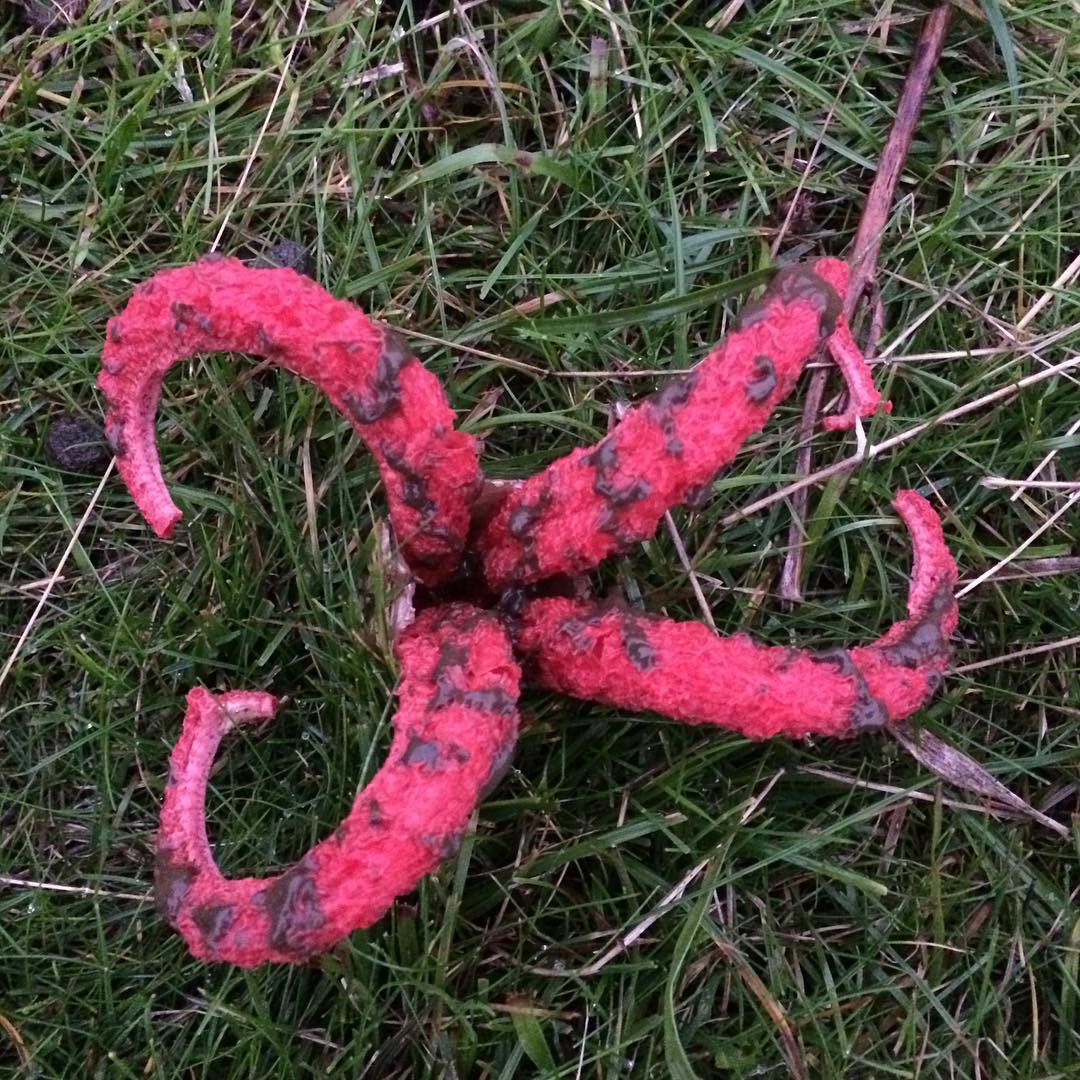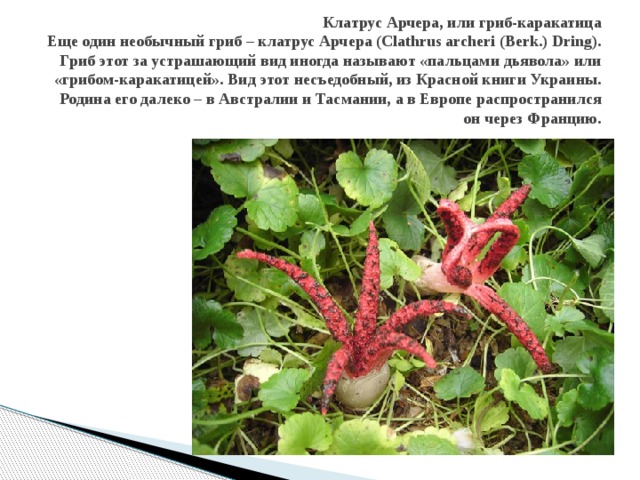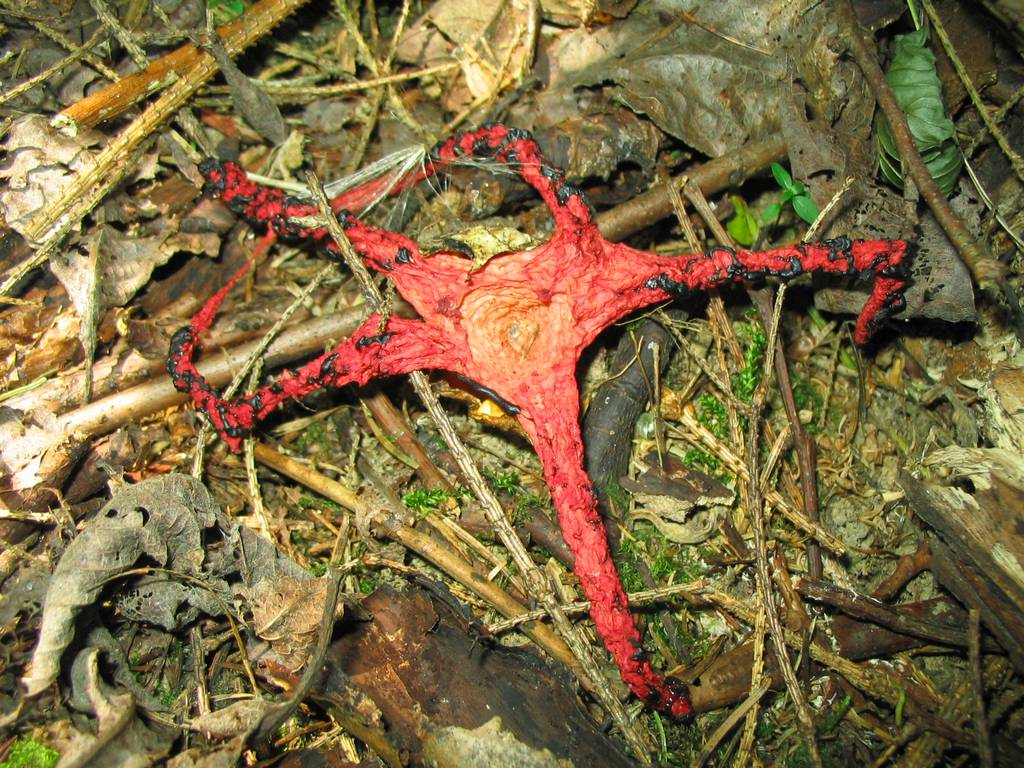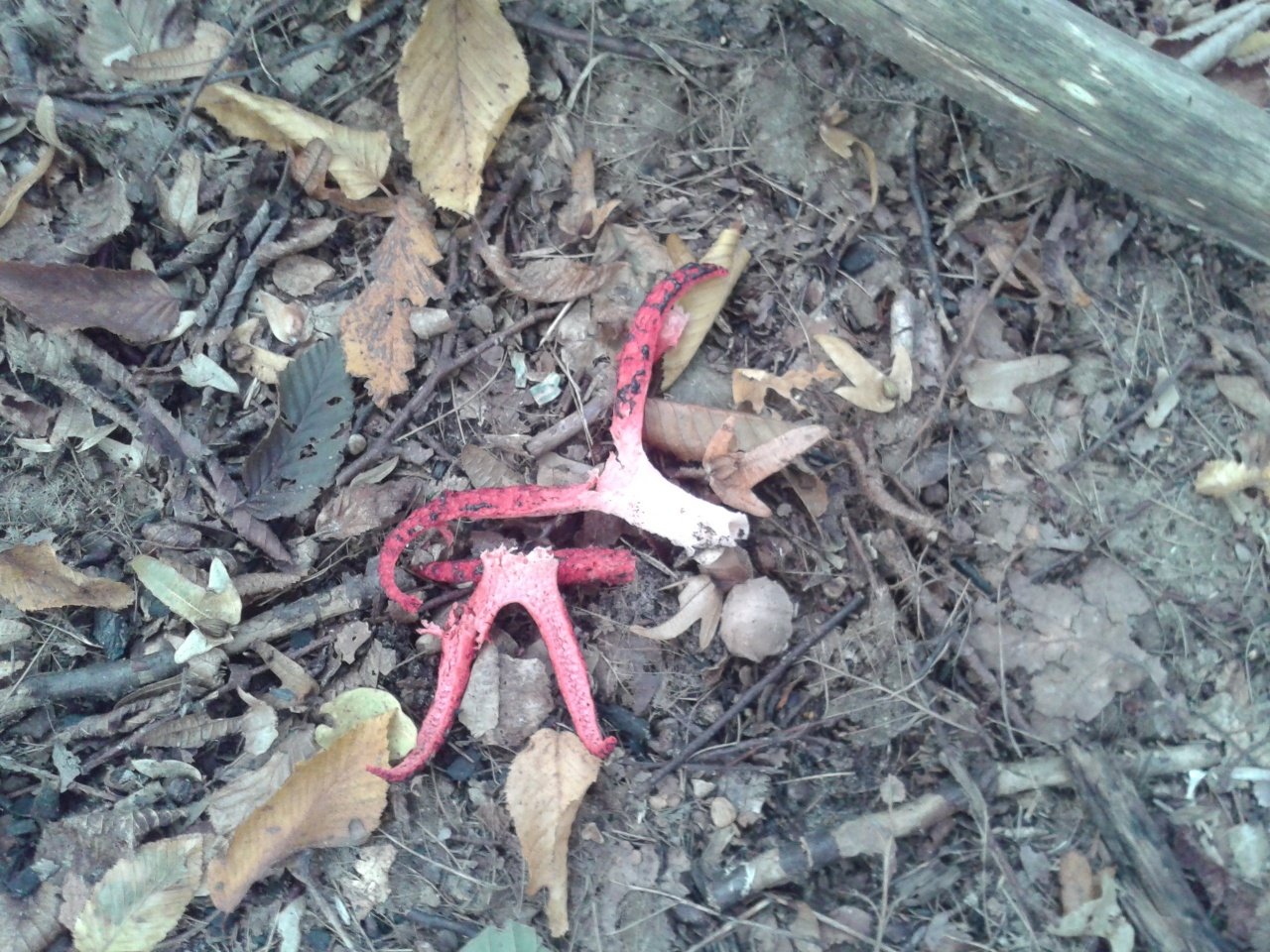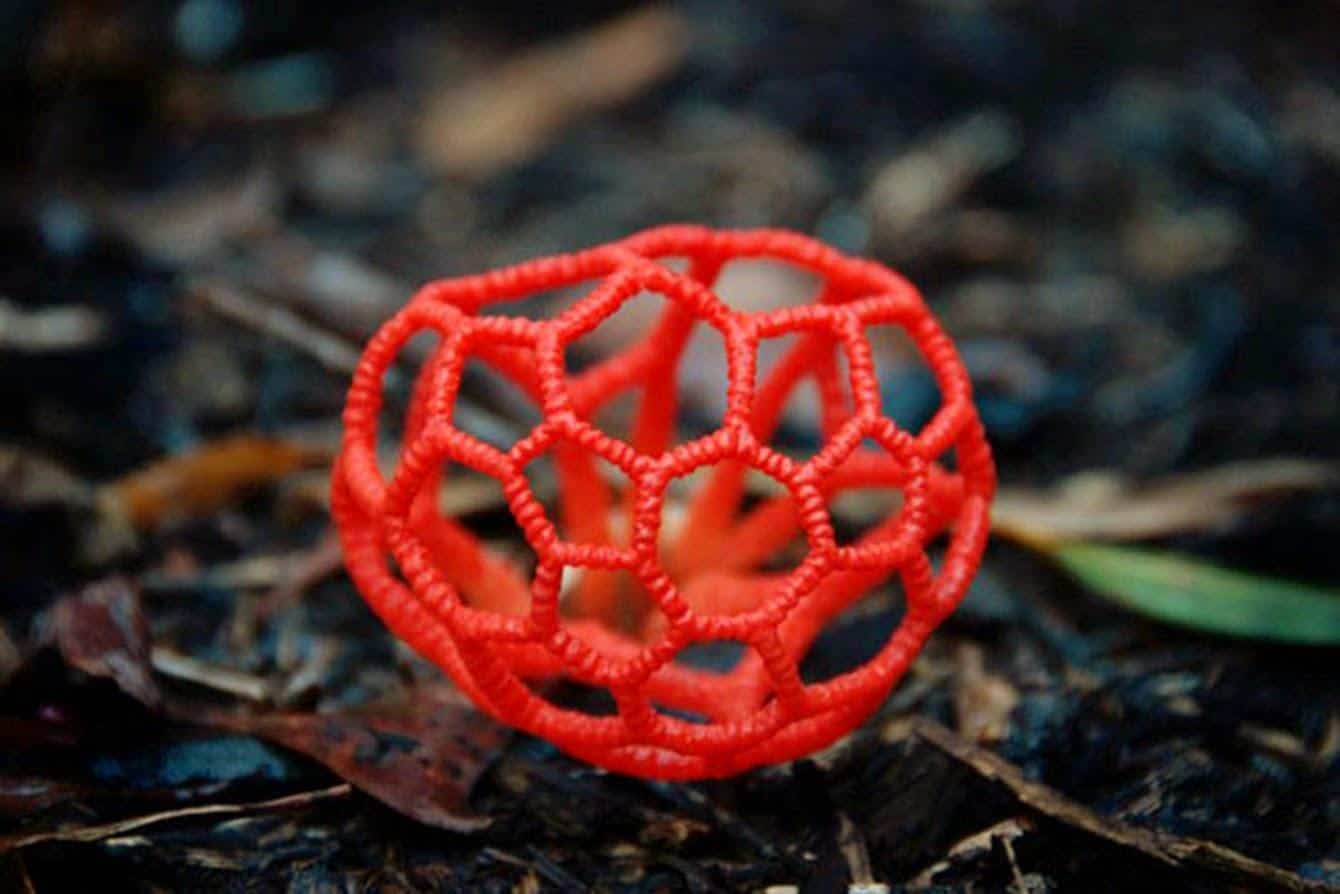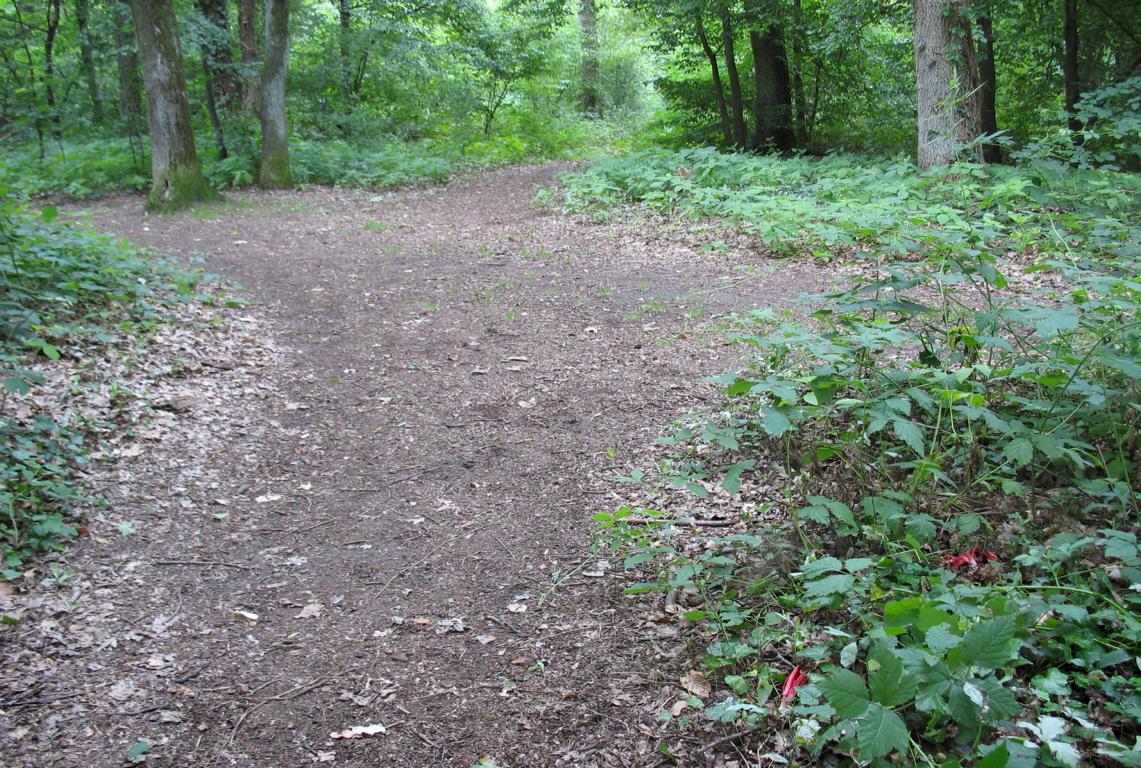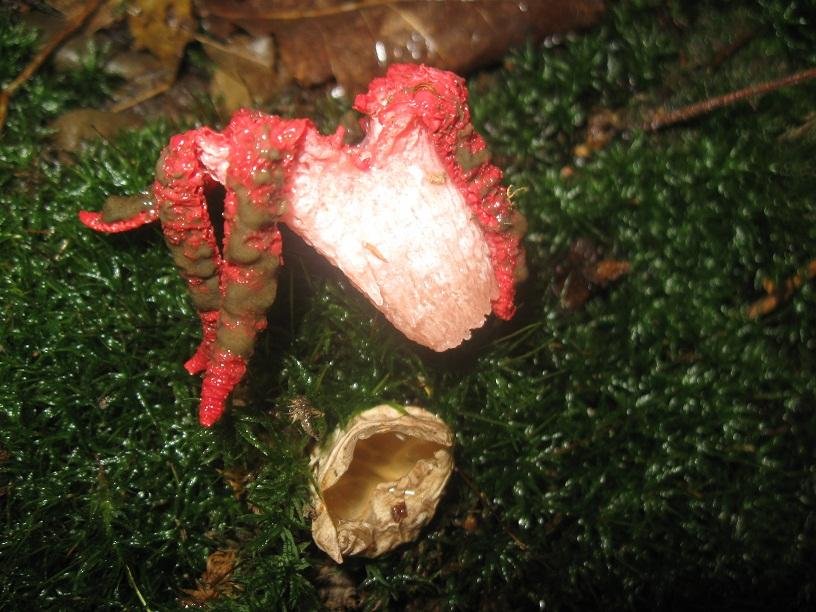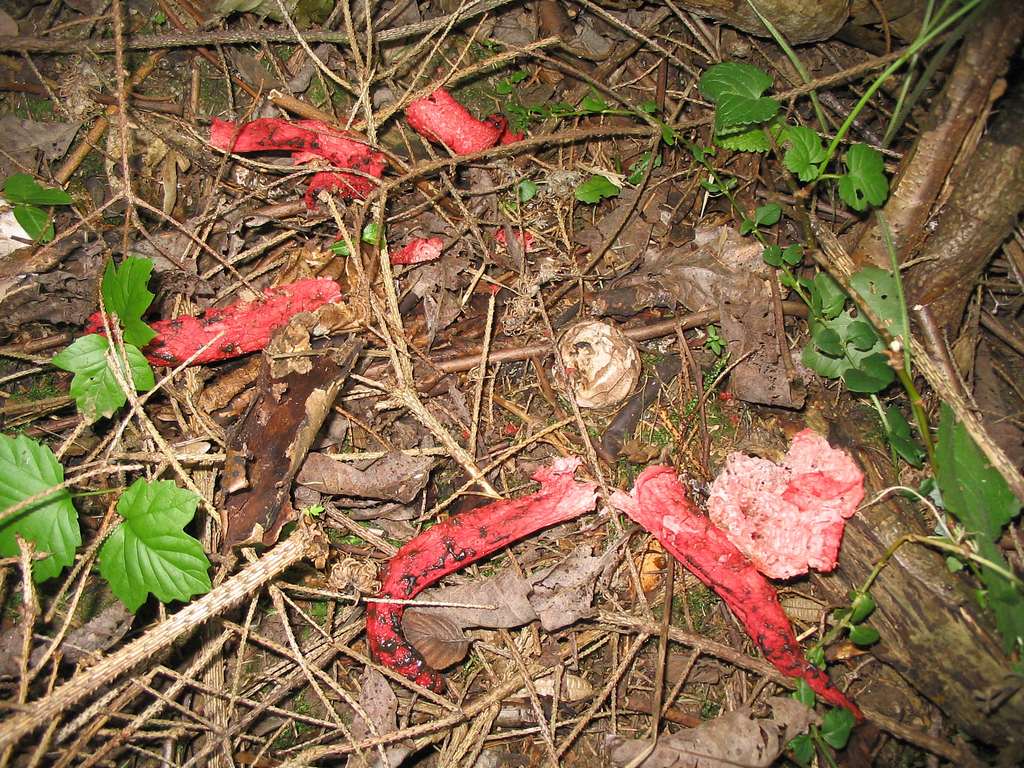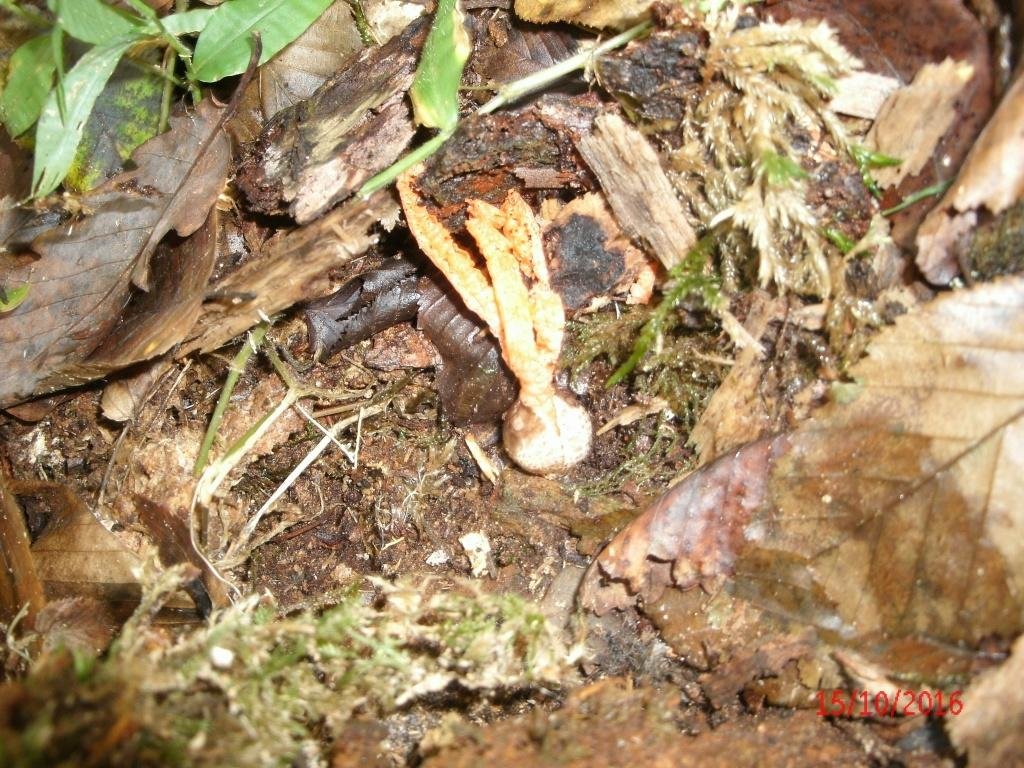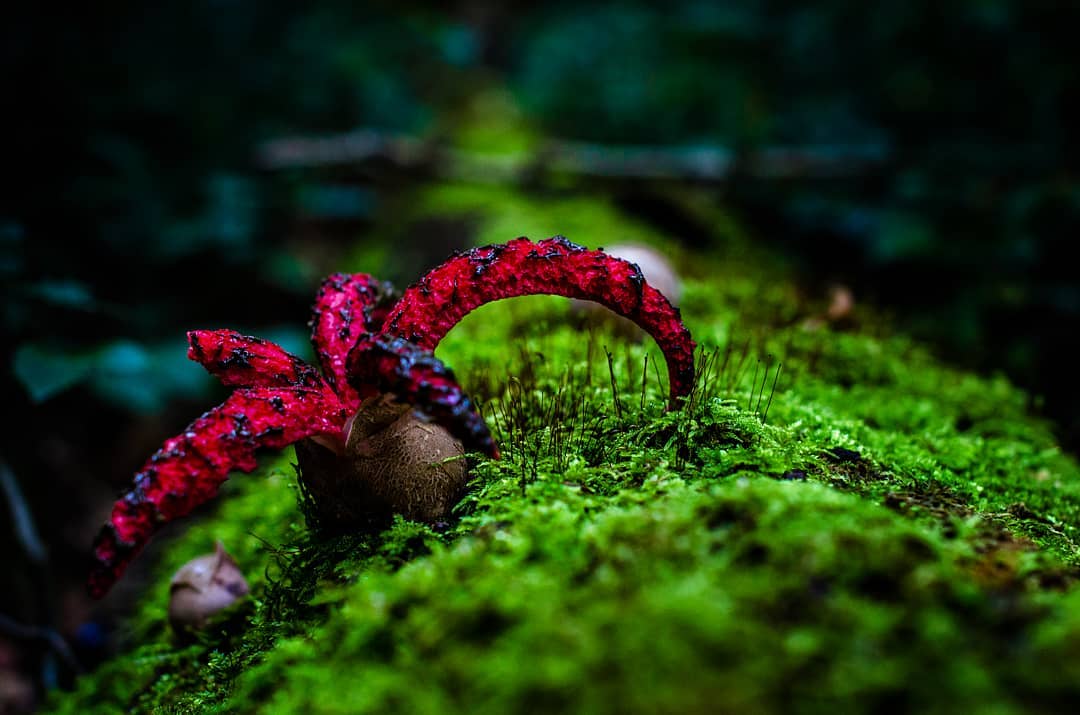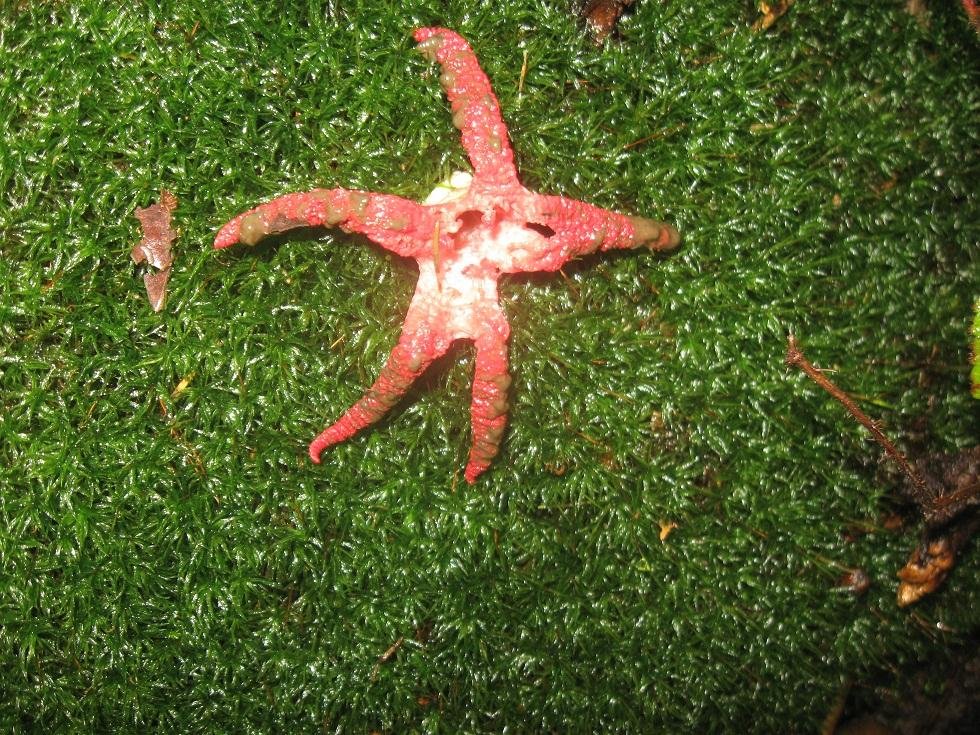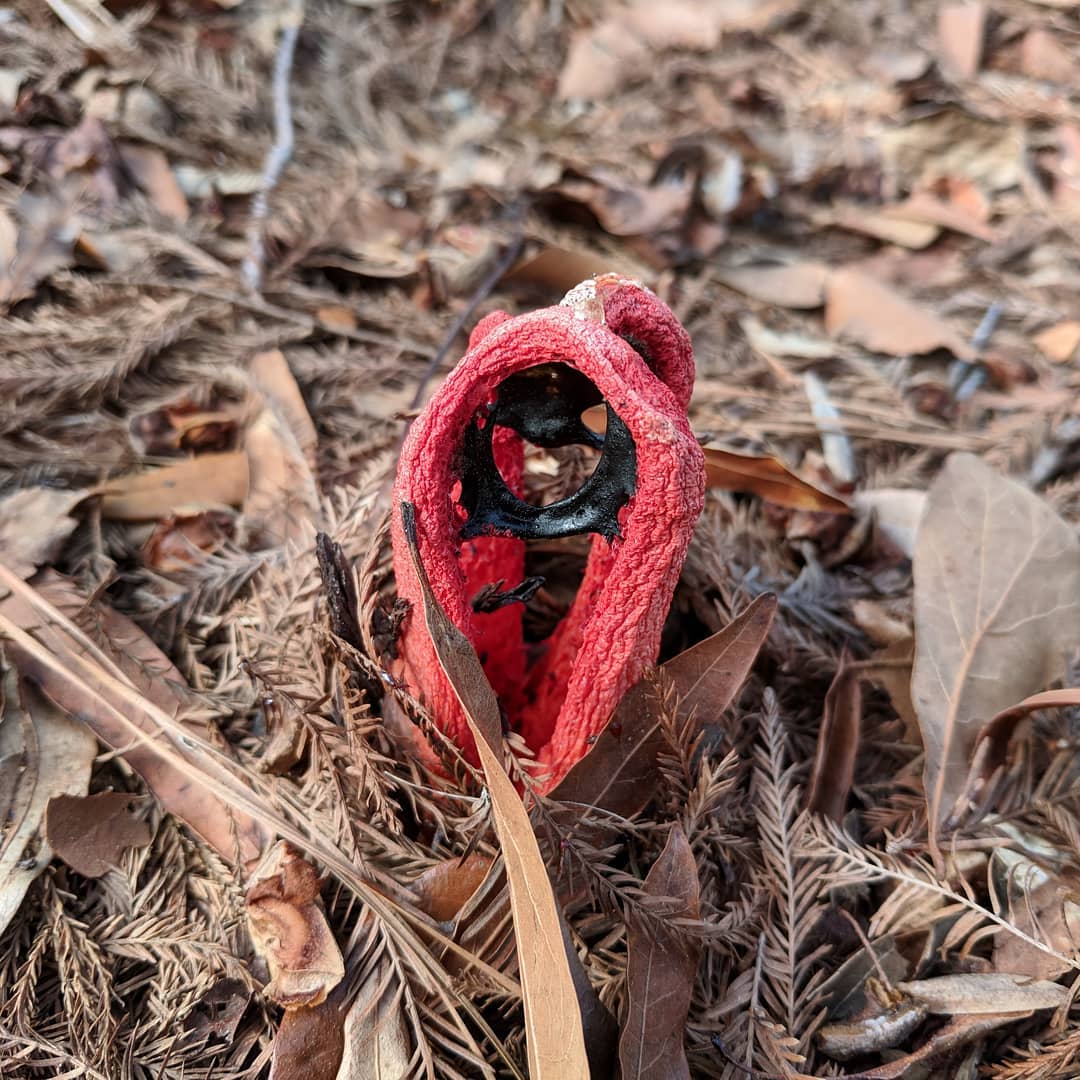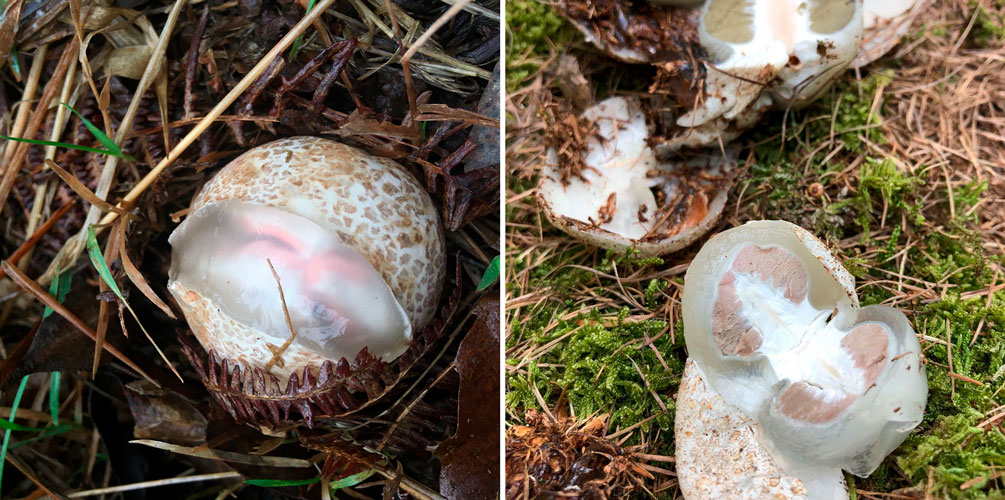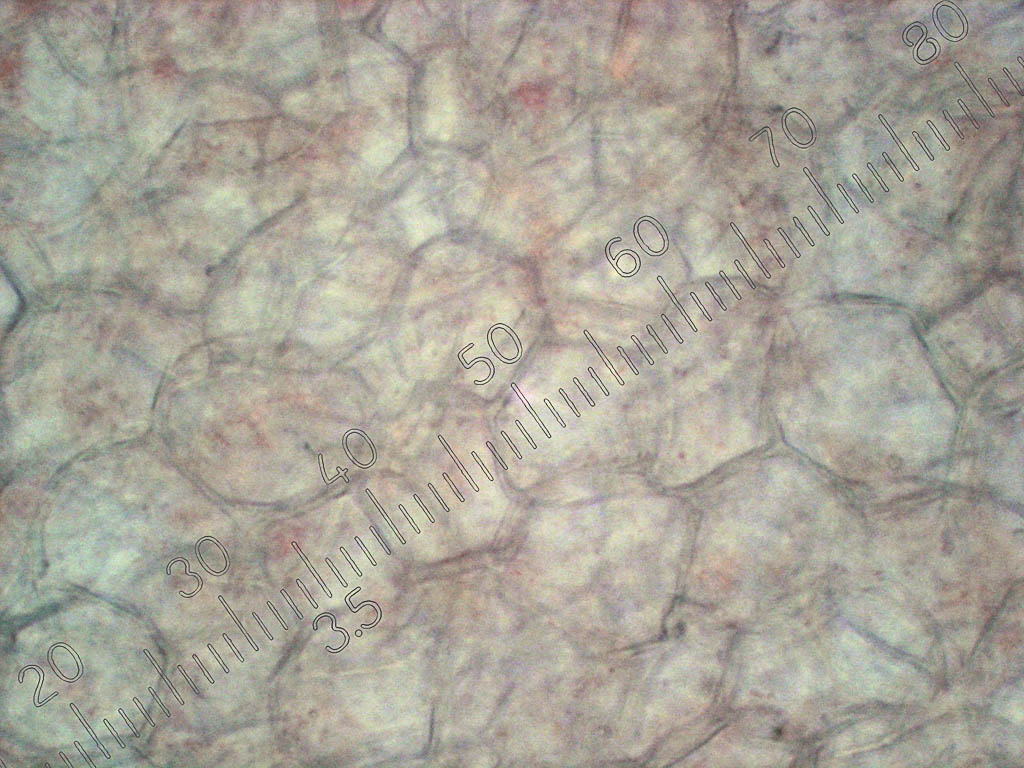Almost related
With all the originality and dissimilarity to other forest dwellers, there are species that are quite close and similar:
- Javanese flowertail (Pseudocolus fusiformis syn. Anthurus javanicus). You can meet him in the forests of the Primorsky Territory. Visit the Nikitsky Botanical Garden (possibly somewhere else) and find it in a tub where one of the tropical plants is planted. It differs from Archera in petals converging at the top.
- Red Lattice (Clathrus ruber). This mushroom is very rare.
- Common Veselka (Hallus Impudicus). There are considerable similarities in the state of the egg. It differs from the “fingers” only in the color on the cut; in the vest it is green.
Description
Mushroom Anturus Archeri (from Latin Clathrus archeri) of the genus Grate of the Veselkov family is called by the folk "the fingers of the devil". Other names: Archer's Flowerbrew, Archer's Clathrus, Archer's Trellis and Cuttlefish Mushroom.
Homeland are forests and meadows, less often the sand dunes of Australia and New Zealand. Over time, it spread throughout Europe, California and Britain, but there it is less common and not everywhere. It mainly lives in forests, on soils rich in humus and decaying fallen leaves, less often on sandy plains.
Stages of development
The cuttlefish mushroom usually grows in small groups or one at a time. A young fruit body in the form of a white egg, no more than 4–6 cm in diameter, resembles a simple white toadstool. Its structure consists of a thin upper layer (peridium) and a jelly-like inner layer. The fungus grows, swells, and the peridium shell begins to break through. Then inside, in a transparent slimy cocoon, his frightening purple "fingers" are already visible. This is a recipe of four or five (rarely 6–8) red lobes, which, like tentacles, stick out upward, gathered together. Breaking the fruit membrane, “tentacle fingers” take the shape of a starfish or an octopus, each up to 10 cm long. The average diameter of a mature mushroom is about 16 cm, height - up to 10 cm, while the stalk is not clearly expressed. It has a porous spongy structure, outside covered with dark (from black to marshy) mucus (spore-bearing gleba), which exudes the smell of rotting meat. Although it is not poisonous and not dangerous, it does not represent any nutritional value for people.
The fetid and vibrant fungus attracts many insects and animals. Archer's flower breeder is not carnivorous, but reproduces thanks to the flies that carry its spores. After release, the blades wither rather quickly (on average in 2-3 days, depending on weather conditions) and fold back together. Then the devil's fingers take on an equally creepy look, somewhat reminiscent of a human hand.
A bit of history
It was first found and described by the traveler and mycologist Michael Joseph Berkeley (from Great Britain) in the southernmost part of Australia, on the island of Tasmania, in the second half of the 19th century. At that time, it was endemic, that is, it was its only reliably known place of distribution.
Over time, mushroom spores, along with seafarers, came to the Old World. In France, it was first discovered after the First World War. Another century later (in 1980), another English scientist, Donald Malcolm Dring, in his monograph ranked Anturus Archer as a member of the Clathrus genus.
Description
Mushroom Anturus Archeri (lat.Clathrus Archeri) belongs to the genus of trellis of the family of merry. Sometimes it is also called Clathrus Archer, Devil's Fingers or Cuttlefish Mushroom. There is also the name of Archer's Flower-Tail.
First, the fruiting body of the fungus (its aerial part) of a spherical or pear-shaped shape with a diameter of 5-6 cm, gray-white with a brownish and pink tint, appears on the surface. During this period of development of the fungus, it differs little from ordinary inhabitants of our forests, for example, a simple pale toadstool.

The most amazing metamorphoses occur after the shell breaks open, and from it the very frightening-looking red "fingers of the devil" or the recipe, as mycologists call it.
It consists of 3-8 blades fused at the apex, similar to tentacles.As they grow, they separate and open, becoming like a bizarre exotic flower or a red starfish with a diameter of 10-15 cm. Anturus Archer does not have a mushroom leg in our usual understanding. The surface of the so-called tentacles is covered with a greenish mucous substance called gleba. It is here that the spores of the fungus are formed, by which it reproduces.
Anturus Archer has a very unpleasant smell and resembles the smell of decomposing meat. Many plants and mushrooms use these tricks. Plants do this for fertilization, and fungi do this so that insects carry their spores on their paws.
The mushroom itself lives for two or three days, and then withers and dies. But this time is quite enough for Archer's Flowerbrew to fulfill its main purpose - to form and spread spores, thereby giving new life to other mushrooms.
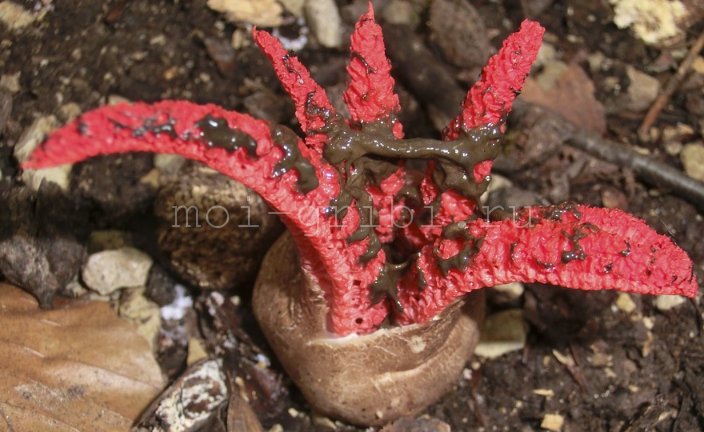
Growing places
Anthurus Archer is a native of Australia and New Zealand. Its favorite habitat there are forests, where there are many stumps, decaying wood chips or fallen leaves. Since the beginning of the twentieth century, the mushroom was introduced to Europe, and then slowly conquered vast territories, up to the Urals. In European conditions, he prefers deciduous, coniferous or mixed forests with acidic soil, as well as felling areas, where a lot of rotting sawdust accumulates.
Evaluation of nutritional qualities of Clathrus Archer
Clathrus Archer is an inedible fungus, it has no nutritional value.
Close species
The Javanese florist is a closely related species of Clathrus Archer. It is also an inedible mushroom. The shape of the fruiting body resembles a spindle, consisting of 3-8 lobes. At the top, the blades are connected. The color of the blades can be whitish, pink, orange and red. The leg is not expressed, very short, hollow inside. The pulp of the mushroom emits a pungent specific odor that insects like.
The Javanese flower breeder is native to Australia, but it has made its way to Europe, New Zealand, North America and Africa. Also, these mushrooms are found in the Transcaucasia, in the Primorsky Territory and the Crimea. They grow in forests and parks, sometimes they can be found in sand dunes. They settle on decaying forest litter and soil rich in humus. This is a rare mushroom listed in the Crane Book.

The red grate is a rare inedible mushroom. The fruit body is ovoid or spherical, 5-10 centimeters in diameter. The upper part of the fruiting body is reticulate, red, yellowish and rarely whitish. The legs are not available. The mushroom smell is unpleasant. This is a mushroom from the Red Book of Russia. Fruit bodies grow singly or in small groups. They settle in deciduous forests. These mushrooms are found in the Krasnodar Territory, the Moscow Region, in the Crimea and Transcaucasia.
Columnar lattice (Clathrus columnatus)
Synonyms:
- Laternea columnata
- Linderia columnata
- Colonnaria columnata
- Linderiella columnata
- Clathrus colonnarius
- Clathrus brasiliensis
- Clathrus trilobatus
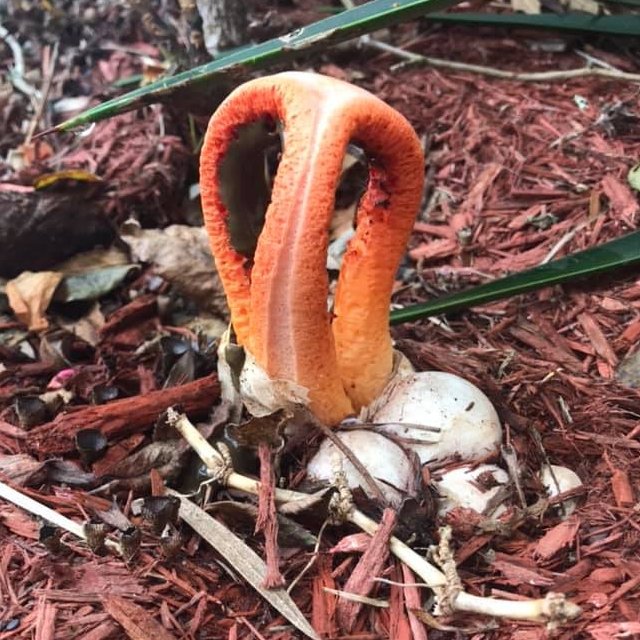
Description
Like the other Vesyolkovs, Clathrus columnatus is born from an “egg”.
At the egg stage, the fruiting body is partially immersed in the substrate, it is rounded, almost spherical, may be slightly flattened at the bottom, 3x5 centimeters, with longitudinal grooves corresponding to the insertion of the peridial sutures and, therefore, to the lobes of the receptacle. If you make a vertical cut, you will see a rather thin peridium, very thin at the top, thicker at the base, behind it is a gelatinous layer up to 8 mm thick, and inside there is a rounded gleb with a diameter of about 1.7 cm, which occupies the upper part of the central part of the egg.
The outer shell of peridium is often white, less often creamy, creamy to pale brown, sometimes cracking, forming angular brown scales. Quite strong strands of mycelium leave the egg into the substrate, which, if desired, can be excavated and traced to roots, stumps and other woody materials immersed in the substrate.
When the egg shell breaks, a fruiting fruiting body unfolds from it in the form of separate lobes, fused at the top. They resemble graceful curved columns or brackets. There can be from 2 to 6 such blades. The inner surface of the blades is covered with spore-containing mucus with a specific odor that attracts flies. Flies are the main spores of fungi of the entire family of merry mushrooms.
The height of the blades is 5-15 centimeters. Pinkish to reddish or orange in color, paler below, brighter above. The thickness of each blade is up to 2 centimeters at its widest part.
In some cases, two adjacent blades can be connected by a transverse bridge, especially near the upper part of the structure, or sometimes there may be an incomplete transverse process attached to only one blade. In section, each blade is an ellipse with a longitudinal groove on the outside and a rather complex system of grooves and grooves inside.
The blades have no legs or some common base; they come out directly from the burst egg, which remains in the form of a volva.
Spore-containing mucus (namely, "mucus", since there is no spore powder in the form of a "powder" in the jellyfish) abundant, initially compact mass, attached to the upper part, where the blades are connected, and slowly sliding down, at first olive-green, gradually acquiring olive -brown, dark.
Spores are cylindrical with rounded ends, 3-4 x 1.5-2 microns.
Ecology
Like all Phallaceae species, C. columnatus is saprophytic and uses extracellular digestion to extract nutrients from dead and decaying organic matter such as wood. Due to its tendency towards dead wood, the fungus is often associated with disturbed habitats. Often found growing in and around gardens, parks, clearings, where human activities have resulted in accumulations of mulch, wood chips or other cellulose-rich materials.
Season and distribution
Spring - autumn.
The fungus has been found in Australia, New Zealand, Oceania, New Guinea, Africa, as well as in North and South America, Hawaii, and China. It is believed to have been introduced to North America as it usually appears in landscaped areas or other places where exotic plants have been planted.
Similar species
The Javanese flower barker (Pseudocolus fusiformis) is considered the most similar. It has 3-4 lobes growing from a common stem (which can be very short and hidden in a volva). Its "eggs" - and therefore the Volvo - are usually greyish to greyish brown (not white or off-white).
The best and easiest way to distinguish the Columnar Grid from the Javanese Flowerbrew is to cut the Volvo and pull the entire structure out of it. If there is a common stem, it is a flower stalk. If the "pillars" are not connected to each other in any way, there is no common foundation - this is a columnar Grid. We are talking about mushrooms in an adult state, of course. Accurate identification of merry beetles at the “egg” stage is often impossible.
Photo: Veronica.
Interesting Lattice Facts
The type of trellis in question is a rather rare type of mushroom. For this reason, it is included in the Red Book of the Russian Federation.
Despite the fact that this specimen is inedible, it is impossible to poison them. Firstly, it is rare, and purposefully none of the mushroom pickers will look for it. Secondly, the fruit has such an unpleasant odor that you hardly want to take it home and use it in cooking. In addition, not everyone knows that this seemingly interesting plant belongs to the kingdom of the Mushrooms.
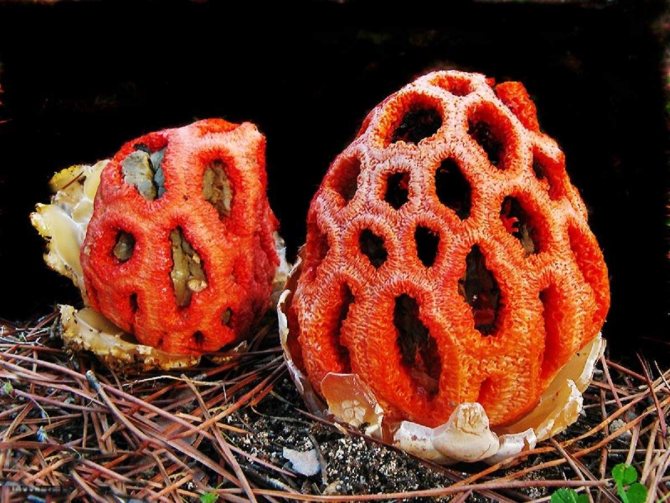
You may be interested in: What is the difference between edible talkers and false mushrooms How many days after the rain mushrooms grow Bitter mushroom: photo and detailed description
Despite the fact that touching this specimen is prohibited by law, it is sometimes used as an element of home decor.In this case, if there are children in the house, it is necessary to prevent their contact with this plant. Adults cannot be poisoned by a lattice, but kids are not immune from this. If the child accidentally consumed the fetus, then intoxication will manifest itself with severe vomiting and diarrhea. The manifestation of poisoning occurs several hours after taking the mushroom, and only on condition that the parents did not seek help from a doctor in a timely manner, or do not know about the situation.
In case of manifestation of symptoms of general intoxication associated with the accidental use of a lattice, it is necessary to immediately call an ambulance. Before her arrival, the child must be provided with plenty of fluids. It is not recommended to give food without the permission of a doctor. With timely intervention, the symptoms of red lattice poisoning completely disappear after 10-12 hours, without causing harm to the child's health.
On a note!
The grill not only has no nutritional value, but also does not have any special beneficial properties. It is not used in traditional medicine or pharmaceuticals.
The number of red myceliums and other varieties of trellis is rapidly decreasing. For this reason, such a miracle of nature must be carefully protected, since there is benefit from it, even if it has no relationship with the human body. You should not trample on these fruits, finding them in the forest, just because they exude an unpleasant odor. Seeing such a copy, you must inform the appropriate authorities. In the future, it is they who will be engaged in the protection of the red lattice and species similar to it.
Leaky mushroom clathrus red
Much less often in the southern zone, where the climate is warm and mild, there is another type of clathrus - a red mushroom. Solar lighting does not play a special role for him, moreover, most often it is found precisely in the dense shade of deciduous thickets. But the clathrus is not able to do without heat - the mycelium of the fungus will irrevocably die if the temperature drops below 5 degrees Celsius.
On this topic:
BACK
FORWARD
1 of 42
Young mushrooms are similar to Archer's clathrus and also have an egg-shaped gray-white color. As the egg “ripens”, it turns red, and then the reticular membrane breaks, and openwork petals with small pores become visible. Over time, the pores expand, forming large holes-cells, as in a lattice, because of which the mushroom is also called the red lattice. There is a torn fringe along the edge of such cells. Instead of a leg, the clathrus has, as usual, the remains of an egg. It is simply impossible to confuse a mushroom with others: not only does it have an unusual shape and a bright red color, it also spreads around itself a disgusting smell of rotting meat, while you can hear it even at a distance of 15 m. However, the "aroma" attracts flies and other small insects that carry spores throughout the forest.
Bristly mushroom scutellinia thyroid
On rotting wood, in small families, thyroid scutellinia grows - an inedible mushroom. Orange-red concave caps no larger than a coin in diameter are decorated with long standing bristles at the edges. The flesh of the mushroom is fragile, waxy in structure.
In conclusion, I would like to say that this list of unusual mushrooms, inedible and poisonous, is far from complete. Strange specimens can be found both on the territory of our country and in other climatic zones, the climate of which leaves an imprint on their appearance and features of growth. Just remember that not everything beautiful can be touched with your hands and you certainly shouldn't put it in your basket. Better to play it safe, admire these mushrooms and walk by.
Neon mycene
In the distant rainforests of Australia, Asia, Japan and other countries with warm and humid climates, small fungi of mycene chlorophos are attracted by the soft green light on the remains of trees during the rainy season. Thin, open, sticky-skinned hats emit a neon glow at night and scare tourists for a stunning and fantastic effect.
The brightest light comes from mushrooms at high temperatures (at least 27 degrees Celsius) and lasts up to three days. Data on the edibility of the mushroom are currently lacking, but it is unlikely that it can be eaten.
Thin, open, sticky-skinned hats emit a neon glow at night and scare tourists, creating a stunning and fantastic effect. The brightest light comes from mushrooms at high temperatures (at least 27 degrees Celsius) and lasts up to three days. There is no data on the edibility of the mushroom to date, but it is unlikely that it can be eaten.
False doubles
This mushroom is not the only one of its kind so “elegant”; of the similar brethren, one can note the Javanese Flowerbrew, Red Trellis and Veselka ordinary. Some are simply considered inedible, and some of them are poisonous. All are listed in the Red Book.
1.
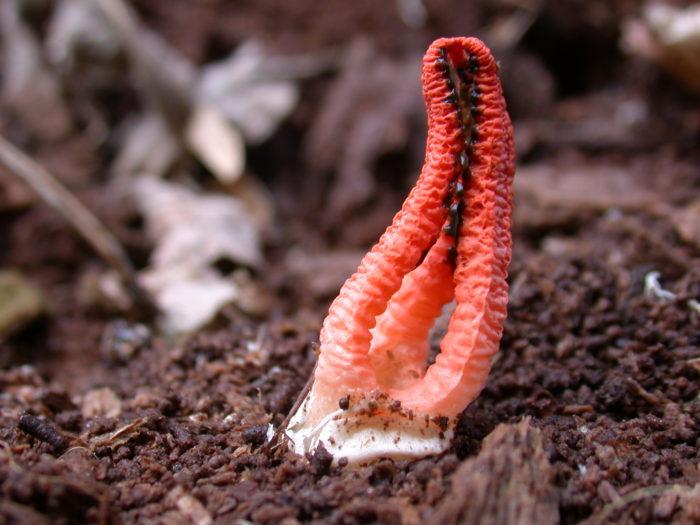 Florist Anturus
Florist Anturus
Javan florist Anthurus (lat.Anthurus javanicus). Also originally from Australia and also at one time was brought to different countries, like the fingers of the devil. It has a similar genus and family, and is distinguished by a lighter pinkish and orange color. At the same time, the recipe at his top is always folded together in the form of a spindle and it also happens with three lobes, and not only with 4–8. Their length does not exceed 5 cm, the flesh is cellular and hollow inside, inedible. During swelling, the eggs resemble the same pale toadstool, only with a smaller diameter than Archer's anturus. It reproduces in the same way, that is, by spores with the help of insects, which are attracted by a pungent fetid odor.
2.
 Red lattice
Red lattice
Red lattice (lat.Clathrus ruber) or, as mycologists call it, Red clathrus. It has a very unusual structure in the form of a lattice ball up to 10 cm high. Cells are round or polygonal with a beautiful fringed structure ranging from bright coral to yellowish. Inside there is an olive-colored spore-bearing boulder.
It is able to remain in a mature state for up to six months, but it is not a deadly poisonous mushroom. In case of poisoning, it causes vomiting and diarrhea, which usually go away on their own within 12 hours, which can only threaten with severe dehydration if the drinking regime is not correct. It grows as solitary individuals in deciduous forests with a rather favorable climate so that the mycelium of the fungus does not freeze until the next flowering (in winter, the temperature should not be lower than 5 C). Therefore, it is found in the southernmost regions, in deciduous, less often in mixed forests, mainly in shady thickets of century-old larch trees. Spores also attract insects with a disgusting odor.
3.
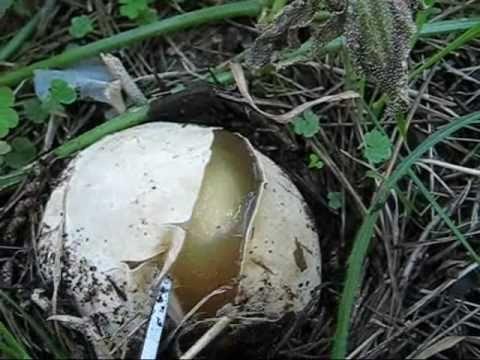 Common fun
Common fun
Ordinary fun, or immodest phallus (lat.Phallus impudicus). As is clear from the strange name, it has an equally amusing phallic shape. It begins to bloom around July, but remains in the egg stage for several weeks. But when it cracks, the mushroom begins to rise at a frantic speed (up to 5 mm / min), growing up to 15 cm. On a hollow, thin leg of whitish color, it has a small cap with a fetid brown-olive mucus that attracts flies. Eggs can be eaten during the stage, but with the same dubious success.
Where mushrooms grow, in which forests
This mushroom grows in the soil. It usually settles in deciduous forests, less often it can be found in mixed forests.
The Krasnodar Territory is the permanent habitat of this species of trellis. But there are several known cases when such specimens were found by mushroom pickers of the Moscow region. They also grow abundantly in the Crimea and the Transcaucasus.
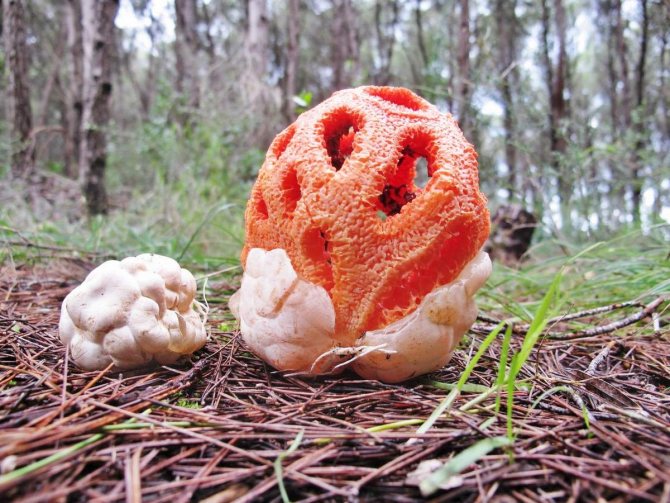
The lattices are very fond of the soil enriched with humus. A good nutrient substrate is also a litter of fallen leaves or rotting wood residues.
The fruiting period of mushrooms begins in the spring and ends in the fall. The exact timing of growth depends on the climatic conditions and the specific region.
Growing at home
Of course, no one has yet dared to grow it at home, but there was one daredevil from California who wanted to know what Archer's Flowerbrew tasted like. He ventured to try the mushroom in the egg stage and experienced nothing but disgust and slight indigestion. In general, its use does not bear any consequences. Therefore, you can eat the fingers of the devil, but only if you are a hobo dying of hunger.
If you want to grow a mushroom on your own in the country, then for successful cultivation you need very little: acidic soils with a thick layer of rotten foliage and sawdust, rich in humus.
The many-sided clavaria of Zollinger
In the coniferous forests of Europe and Asia, mainly under oak trees or in moss, a beautiful mushroom, clavaria zolinger, or clavaria pale brown, grows. It is also found in our area, in particular in Primorye, near Vladivostok, mushroom pickers have seen Clavaria more than once in early autumn. It has a short grayish leg (no more than 8 mm), which is practically invisible, and in the upper part it immediately begins to branch out, forming tall plump branches instead of a cap. It turns out a semblance of a bush, the height of which can reach 15 cm, while the tubular branches themselves also have lateral formations. If you break them (and this is very easy to do, because the structure of the mushroom body is fragile), you can see the brownish flesh, emitting a faint but unpleasant smell of radish, for which the mushroom is classified as an inedible species.
As for the color of such bushy mushrooms, it can be very diverse, giving preference to bright colors:
- snow white;
- cream;
- lilac;
- orange;
- pink;
- purple.
A waking nightmare or Peck's hydnellum
The one who can be used for the scenery of horror films is the hydnellum Peck mushroom. Due to its appearance, it is better known as the devil's hedgehog, the devil's tooth, or the bleeding mushroom. A short thick leg no more than 3 cm in height smoothly passes into the cap, which is the main "decoration": up to 10 cm in diameter, in young mushrooms it is white and velvety, with age it darkens up to brown. There are pores all over the surface of the hat, from which a scarlet-red liquid flows out and freezes on it in drops. The cork pulp is bitter, but at the same time emits a pleasant smell, reminiscent of strawberry.
Archer flower carrier (Clathrus archeri)
- Other names for the mushroom:
- Archer's Clathrus
- Anturus archer
- Archer's grate
Other names:
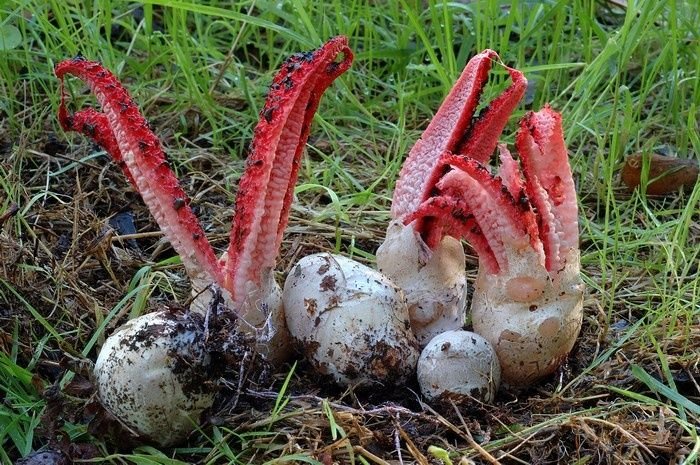
Description:
Young fruiting body up to 4 - 6 cm in diameter, pear-shaped or ovoid, with long mycelial strands at the base. The peridium is whitish or grayish, with a pink and brown tint, after rupture it remains at the base of the fruiting body. From the bursting ovoid envelope, the recipe rapidly develops in the form of 3-8 red, first accrete to the apex, then rapidly dividing and spreading, like tentacles, lobes. Subsequently, the mushroom takes on a characteristic star-shaped shape, resembling a flower with a diameter of about 10 - 15 cm. This mushroom does not have an obvious leg. The structure of the inner surface of the blades resembles a porous, wrinkled lip, covered with dark irregular spots of olive, slimy, spore-bearing gleb, emitting a strong unpleasant odor that attracts insects.
On the cut of the mushroom in the ovoid stage, its multilayer structure is clearly visible: on top of the peridium, under which there is a mucous membrane resembling jelly. Together they protect the fruiting body from external influences. Below them is the core, which consists of a red receptacle, i.e. future blades of the "flower", and in the very center is visible a gleb, i.e. spore-bearing layer of olive color. The flesh of the already opened blades is very brittle.
Spores 6.5 x 3 μm, narrow-cylindrical. Spore olive powder.
Spreading:
The archer flower breeder grows from July to October on the soil of deciduous and mixed forests, occurs in meadows and parks, and is also noted on sand dunes. Saprophyte.It is rare, but grows in large quantities under good conditions.
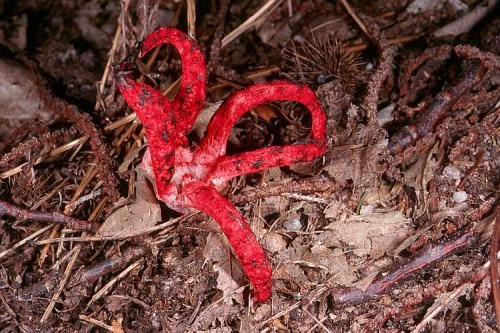
Similarity:
Archer flower carrier - A peculiar mushroom, not similar to others, but there are closely related species:
The Javanese flower barker (Pseudocolus fusiformis syn. Anthurus javanicus), characterized by blades converging to the apex, is noted in the Primorsky Territory, as well as in tubs with tropical plants, in particular, in the Nikitsky Botanical Garden. And, quite rarely, the Red Lattice (Clathrus ruber).
At a young age, in the ovoid stage, it can be confused with the Common Veselka (Phallus impudicus), which is distinguished by the green color of the flesh on the cut.
Rating: Archer flower-carrier - Doesn't matter for food.
The pungent, repulsive smell of the fruiting body of the Archer flower stalk, as well as the bad taste of the pulp, determines the fact that the fruiting bodies of this species are correlated with inedible mushrooms. The described mushroom is not eaten.
Note: History of penetration: Australia is considered to be the ancestor of the fungus, but for Europe it is an alien. It was first discovered in France in 1914, possibly, its spores were brought together with wool, which was imported at that time from Australia. Subsequently, the mushroom was found in southern Germany (1937), Switzerland (1942), England (1945), Austria (1948), Czech Republic (1963), Spain (1973). It traveled to the shores of the Baltic Sea for more than 60 years, and today it is increasingly celebrated on the Eastern European continent.
Etymology: Clathrus (m) from Greek kleithron. with a similar meaning claustrum lat. 1) bolt, lock; 2) storage, cage. Also kleis Greek. bolt, constipation. Pinea claustra - pine dungeon - this is how Virgil wrote about the Trojan horse. The epithet archeri is given in honor of the Irish mycologist W. Archer.
Previously, the described type of mushroom was attributed to rare specimens, but now lovers of quiet hunting find more and more fruiting bodies of this species.
Conclusion
Anturus Archer is an inedible species. It has a nasty taste, the stench of a decaying mass of animal origin and a long nasty aftertaste (as the daredevils who dare to try it say). However, they cannot be poisoned or sick after consuming it.
Devil's fingers at an early stage of development are outwardly somewhat similar to the white toadstool, but this mushroom does not pose a mortal threat.

